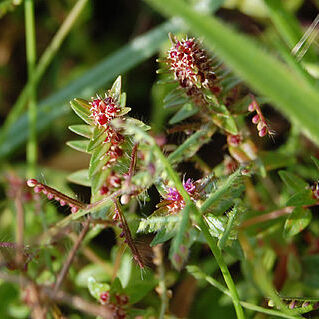Herbs, annual, 10-50[-100] cm tall. Stem with numerous, ascending branches. Leaves opposite on basal stem portion, opposite or alternate toward stem apices, narrowly elliptic or oblanceolate to linear, 5-60 × 3-10 mm, base attenuate, truncate, or subcordate. Flowers 3 to many in dense axillary cymes; pedicels subsessile, to 1 mm; peduncle absent to 1 mm; bracteoles minute, not reaching floral tube. Floral tube campanulate, tapering at base, 1-2 mm; sepals 4, ca. 0.5 mm, deltate; epicalyx absent. Petals absent. Stamens 4. Style absent to 0.3 mm, much shorter than ovary. Capsules 1-2 mm in diam., 1/4-1/2 exserted. Fl. Aug-Oct, fr. Sep-Dec. 2n = 24, 26.
Herb, erect, branched, to 100 cm high. Leaves opposite, mostly subsessile; lamina oblong-linear to lanceolate or narrowly elliptic to elliptic, to 8 (–110) cm long, acute, the base attenuate. Flowers in crowded axillary cymes or clusters; peduncle to 1 mm long; pedicel to 3 mm long. Hypanthium campanulate, c. 1–2 mm deep; appendages reduced or absent. Sepals short-triangular, 1–1.5 mm long. Petals absent. Stamens 4, included. Capsule globose, 1–2 mm diam., exceeding hypanthium; dehiscence irregular.
Annual herb, 3-45 mm high. Leaves with blade linear to elliptic, 10-40 mm long, bases cuneate or cuneate at base of plant and auriculate at top of plant, rarely all auriculate; pedicels 0.5(-2.0) mm long. Flowers: sessile in compact cymes, petals 0 or very small, white (if present); Oct.-Apr. Fruit bright red to purple, spherical, 1.0-1.5 mm in diameter.
A herb. It grows 7-32 cm high. The stems can be erect or lie along the ground. The leaves often droop. They are broadly sword shaped. They are 1-47 mm long by 1-9 mm wide. The flowers are small and white. They are in small clusters in the axils of the leaves. The fruit are flattened round capsules.
base of plant and auriculate at top of plant, rarely all auriculate. Pedicels 0.5(-2.0) mm long. Petals absent or very small. Style 0.12-0.30 mm long. Flowers white (if petals present).
Dichasia (1–2)3-to many-flowered, lax or dense; peduncles 1 (2) mm. long; bracteoles linear-lanceolate; pedicels 1–2·5 (4) mm. long.
Leaves 7–70 × 1·5–10 (16) mm., elliptic to linear, attenuate at the apex, attenuate-cuneate or obtuse to subcordate at the base.
Calyx-tube 1–1·2 mm. long, turbinate-campanulate; lobes 4; appendages 0 or inconspicuous.
Capsule 1–2·5 mm. in diameter, globose, 1/2 to 3/4 included in the calyx.
Ovary 0·7–1·2 mm. in diameter, globose; style 0·1–0·3 mm. long.
Annual erect or ascending ± branched herb up to 80 cm. high.
Stems and branches reddish, 4-angular, winged to the apex.
Stamens 4, as long as the calyx-lobes or shorter.
Seeds c. 0·4 mm. in diameter, brownish.
Erect herb, to 2 ft. high
Flowers mauve
Petals 0.


